Wiltshire
Explore hidden histories, historic photos, and things you never knew about Wiltshire from the collections and archives of Historic England.
Discover your local listed buildings and places
Introducing some of Wiltshire's most historic sites, included in the National Heritage List for England. Some of these captions have been summarised by AI. Click through for the official List entry. Skip this section and go to place by numbers
Health Hydro (former GWR Medical Fund Baths and Dispensary)
South Swindon
Dispensary and swimming baths, now health hydro, built in 1891 for the Great Western Railway (GWR) Medical Fund Society, designed by JJ Smith of Swindon; washing baths built in 1898-9;...
MoD CORSHAM: Tunnel Quarry
Corsham
A series of below ground transport infrastructure comprising two railway platforms, a conveyor control room, conveyors, a slope shaft, a power station, and a locomotive shed.
Officers Mess, Jellalabad Barracks (Building No 73)
Tidworth
An officers' mess of 1905, part of Jellalabad Barracks, Tidworth Camp. Read the official list entry to find out more.
Trowbridge General Cemetery
Trowbridge
A mid-C19 Burial Board cemetery laid out to the design of C E Davis of Bath. Read the official list entry to find out more.
MoD CORSHAM: Slope Shaft (Emergency Exit) A
Corsham
A part-inclined and part-vertical shaft, probably originally constructed to provide ventilation in Spring Quarry, Corsham in the C19.
MoD CORSHAM: Prime Minister's Rooms and Operations Rooms
Corsham
A group of rooms built from breezeblock and brick into the existing stone pillars of the former Spring Quarry.
The former Swindon Steam Laundry
South Swindon
Part of a former cheese factory owned by the Aylesbury dairy Company dating from the 1870s, converted into a steam laundry in c1891 to a design by Ellis Herbert Pritchett, with late C20...
The Spectrum Building (formerly the Renault Distribution …
West Swindon
A warehouse for storing vehicle components, with showroom, offices and ancillary facilities, built in 1981-2 for the car manufacturer Renault to designs started in 1979 by the architect Sir...
Rybury camp
All Cannings
Rybury Camp is a Neolithic causewayed enclosure and slight univallate hillfort, notable for its historical significance and well-preserved archaeological and environmental evidence.
Littlecote House
Chilton Foliat
Littlecote House, built by William Darell in the late 16th century, features walled gardens, a deer park, and a Roman villa discovered by Sir Francis Popham in 1730.
Stonehenge, Avebury and Associated Sites
All Cannings
Stonehenge and Avebury, in Wiltshire, are among the most famous groups of megaliths in the world.
Former Church of St Edmund
Salisbury
15th century nave, originally a chancel; tower of 1653-5. Reseated and restored by Sir G.G.
Odstock Manor House
Odstock
Odstock Manor House, built in the late 17th century and altered in the 18th and early 20th centuries, has historical ties with the Webb family since 1541.
Tottenham House and Savernake Forest
Burbage
Tottenham House and Savernake Forest feature 18th and 19th-century pleasure grounds and parkland designed by renowned landscape architects Richard Boyle and Lancelot Brown.
Hazelbury Manor
Box
Hazelbury Manor, dating from the 14th century, underwent major restorations and extensions in the 20th century, and features various historic garden spaces within a 2.75-hectare site.
Swindon Civic Offices
South Swindon
Civic offices for the Corporation of Swindon, 1937-1939, by Bertram, Bertram and Rice, AARIBA, with associated pergola. Read the official list entry to find out more.
Amesbury Abbey
Amesbury
Amesbury Abbey is a historic estate featuring 18th and 19th-century gardens and park, with contributions by Charles Bridgeman and buildings designed by Thomas Hopper and Sir William...
Norton Manor
Norton
Norton Manor is a Grade II* listed early 17th-century manor house with significant historical extensions and modifications, featuring Jacobean and classic architectural elements.
Giant's Cave: a chambered long barrow 750m south west of …
Luckington
The Giant's Cave long barrow, a Neolithic funerary site, is of national importance due to its rarity, age, and well-preserved state, providing archaeological and environmental insights.
Sticke Tennis Court to West of Hartham House
Corsham
A covered Stické Tennis Court built in the 1890s at Hartham Park for Sir John Dickson Poynder (later Lord Islington). Read the official list entry to find out more.
Dinton Park (Philipps House)
Dinton
Dinton Park features a 19th-century house designed by Jeffry Wyatt, surrounded by landscaped gardens and woods, and has been managed by the National Trust since 1943.
Lake House
Wilsford cum Lake
Lake House, built in 1578, underwent restoration after fires in 1838 and 1912. It features extensive gardens, woodland parks, a water garden, and historic monuments.
Swimming Pool Dome at the Oasis Leisure Centre
Central Swindon North
A leisure pool, designed in 1974 by Peter Sargent, ARIBA, with Trevor Wilson and Mark Potiriadis, of Gillinson, Barnett and Partners. Built 1974-1975 and opened on 1 January 1976.
Central Community Centre
South Swindon
Community centre, the central block built in 1862 as the Armoury for the Great Western Railway works; converted to create a hospital for GWR workers, incorporating flanking workers' cottages...
Stonehenge, the Avenue, and three barrows adjacent to the…
Amesbury
Stonehenge and its surrounding area form a World Heritage Site, known for Neolithic and Bronze Age monuments and ceremonial activity, with archaeological significance and astronomical...
Cathedral Church of St Mary
Salisbury
The Cathedral Church of St Mary, with its foundations laid in 1220, is renowned for its historical setting and architectural significance, including notable monuments and restorations.
Stourhead
Brewham
Stourhead features an extensive landscape garden with contributions from the 18th to 20th centuries by notable figures like Henry Hoare II and Richard Colt Hoare.
Former GWR works entrance, pedestrian subway and former c…
Central Swindon North
Entrance building to the former Great Western Railway engineering works with pedestrian subway under the railway, 1870, and former carriage trimming shop above, 1870-1872.
Spye Park
Bromham
Spye Park features an early 18th-century garden by Stephen Switzer, with historical developments by the Bayntun family and renovations by notable figures like William Burn in the late 19th...
The Moot and Moot House, Downton
Downton
The Moot and Moot House are historically rich, featuring a mid to late 18th-century garden on 12th-century earthworks, with significant contributions from the Coles family and notable...
White Sheet camp
Kilmington
White Sheet Castle is a well-preserved large, multivallate hillfort with two bowl barrows and a beacon, reflecting its strategic, territorial, and social significance.
MoD CORSHAM: GPO Telephone Exchange
Box
A series of rooms contained within the worked-out chambers of a former Bath stone quarry, adapted to an underground government facility in the mid C20: Central Government War Headquarters...
MOD Corsham: Quarry Operations Centre (QOC) Murals
Box
A series of murals contained within the worked out chambers of a former Bath Stone quarryThe quarry was adapted to use as an underground aircraft factory in the early 1940s.
Longford Castle
Alderbury
Longford Castle features an early 19th-century parterre garden, mid to late 18th-century pleasure grounds, and modifications by Lancelot Brown and Anthony Salvin.
Queen's Park, Swindon
South Swindon
Queen's Park in Swindon was developed from a claypit in the 1940s and 1950s, featuring gardens and memorials, including the 1950s Garden of Remembrance opened by Princess Elizabeth.
Town Gardens, Swindon
South Swindon
Town Gardens in Swindon, developed from old quarries, is a public park featuring paths, rose gardens, bandstands, and historical entrances designed by various architects in the late 19th and...
Romano-British settlement, earthwork enclosure and a sect…
Brokenborough
The monument includes the earthwork and buried remains of an extensive Roman roadside settlement together with an enclosure of prehistoric or Roman date, and a section of Roman road known as...
Airmen's Cross near Stonehenge
Winterbourne Stoke
A memorial erected in commemoration of two pioneer airmen who were killed in a flying accident near Stonehenge in 1912. Read the official list entry to find out more.
Explore more
Search for more listed placesWiltshire through time
This timeline shows the first period of use for buildings and places on the National Heritage List for England, just one of the details recorded for every list entry. Click around to see how Wiltshire changes over time. Skip this section and go to aerial photos
Prehistoric Before AD 43
Prehistory covers a million years of human occupation before the Roman invasion and the introduction of writing. Primarily hunter-gatherers of several human species including Neanderthals, the peoples moved across Europe, hunting animals, exchanging ideas and developing complex culture and belief systems including burial rites and astronomical understanding, as at Stonehenge for example.
Roman AD 43 to AD 410
Britain was invaded by four legions of the Roman army in AD 43, who relatively rapidly conquered England from landing points in Kent. Parts of Wales and Scotland soon followed.
Roman culture brought urbanism, monumental buildings, wide-ranging religious beliefs, writing, and strong social hierarchy. The Roman administrative system was withdrawn in AD 410.
Early medieval AD 410 to AD 1066
This period, often associated in England with Anglo-Saxons and Vikings, saw a reduction in urban living from the Roman period and increased migration from northern Europe.
Traces of this period can be found in cemeteries, particularly in artefacts and in some of the very early churches, as this period also saw the growth of Christianity in Britain.
Medieval AD 1066 to AD 1540
This period, sometimes known as the Middle Ages, began with the Norman invasion in AD 1066. It saw a significant rise in military and defensive buildings such as castles and earthworks, as well as religious houses dominating a largely agricultural landscape.
The monarchy and Church dominated the period, which also saw the break with the Roman Catholic Church and the English reformation.
Post medieval AD 1540 to AD 1901
The Post-Medieval period brought seismic changes to life in England, with religious reformation leading to the democratization of worship and the destruction of hundreds of religious houses.
In parallel, there was a huge expansion of scientific study and enlightenment that permanently altered the nation's social structure and landscape. Industrialization and mass production lead to wider global trade, emigration, and immigration.
20th century AD 1901 to AD 2000
The 20th century saw an incredible expansion of England's transport networks, with suburban growth shadowing rapid infrastructural expansion. The establishment of state schools, hospitals, and modern technical colleges, with new architectural styles, radically changed the appearance of towns and cities.
Two catastrophic world wars and the 1918 pandemic also brought unprecedented change, altering England's built environment and social structures forever.
Prehistoric Before AD 43
Prehistory covers a million years of human occupation before the Roman invasion and the introduction of writing. Primarily hunter-gatherers of several human species including Neanderthals, the peoples moved across Europe, hunting animals, exchanging ideas and developing complex culture and belief systems including burial rites and astronomical understanding, as at Stonehenge for example.
Roman AD 43 to AD 410
Britain was invaded by four legions of the Roman army in AD 43, who relatively rapidly conquered England from landing points in Kent. Parts of Wales and Scotland soon followed.
Roman culture brought urbanism, monumental buildings, wide-ranging religious beliefs, writing, and strong social hierarchy. The Roman administrative system was withdrawn in AD 410.
Early medieval AD 410 to AD 1066
This period, often associated in England with Anglo-Saxons and Vikings, saw a reduction in urban living from the Roman period and increased migration from northern Europe.
Traces of this period can be found in cemeteries, particularly in artefacts and in some of the very early churches, as this period also saw the growth of Christianity in Britain.
Medieval AD 1066 to AD 1540
This period, sometimes known as the Middle Ages, began with the Norman invasion in AD 1066. It saw a significant rise in military and defensive buildings such as castles and earthworks, as well as religious houses dominating a largely agricultural landscape.
The monarchy and Church dominated the period, which also saw the break with the Roman Catholic Church and the English reformation.
Post medieval AD 1540 to AD 1901
The Post-Medieval period brought seismic changes to life in England, with religious reformation leading to the democratization of worship and the destruction of hundreds of religious houses.
In parallel, there was a huge expansion of scientific study and enlightenment that permanently altered the nation's social structure and landscape. Industrialization and mass production lead to wider global trade, emigration, and immigration.
20th century AD 1901 to AD 2000
The 20th century saw an incredible expansion of England's transport networks, with suburban growth shadowing rapid infrastructural expansion. The establishment of state schools, hospitals, and modern technical colleges, with new architectural styles, radically changed the appearance of towns and cities.
Two catastrophic world wars and the 1918 pandemic also brought unprecedented change, altering England's built environment and social structures forever.
Aerial photos of Wiltshire
Aerial photography helps reveal secrets of England's changing landscapes that are impossible to see from the ground. Skip this section and go to archive images
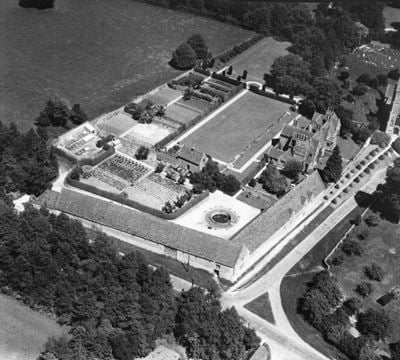
Purton
The Manor House, Purton, 1947

Purton
The Manor House, Purton, 1947
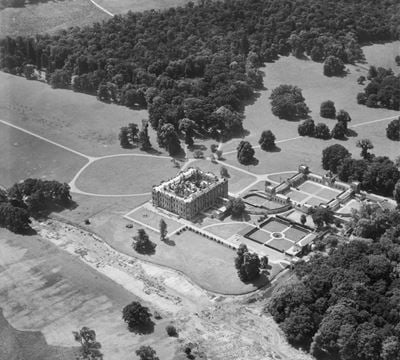
Longleat Park
Longleat House, Longleat Park, 1949
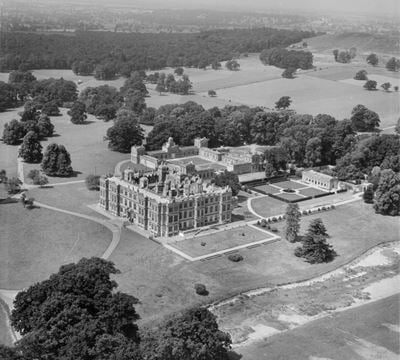
Longleat Park
Longleat House, Longleat Park, 1949

Fovant
Chiselbury Camp hillfort and the Fovant Badges, Fovant, 1950

Fovant
The Fovant Badges and Chiselbury Camp, Fovant, 1953
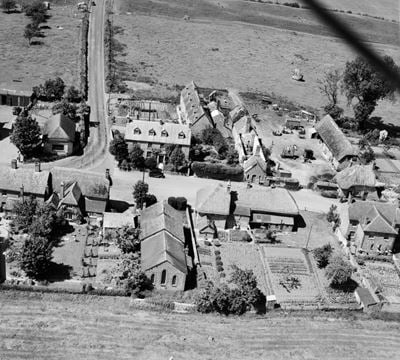
Avebury
The High Street, Avebury, 1947
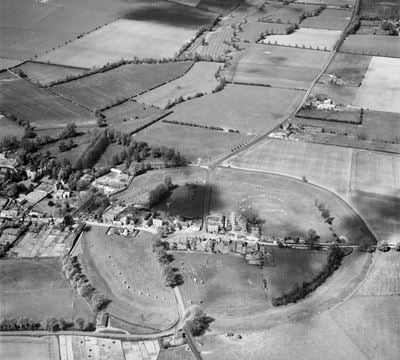
Avebury
The village and the henge monument, Avebury, 1953
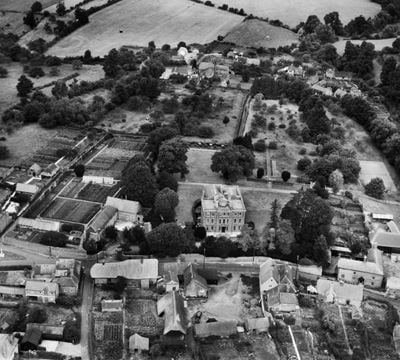
Bratton
Bratton House, Bratton, 1947

Bratton
Bratton House, Bratton, 1947
Wiltshire in the Historic England Archive
The Historic England Archive cares for over 15 million images, dating from the 1850s to the present day. Discover stunning images of Wiltshire's past. Skip this section and go to stories about heritage
Charles George Harper Collection
Great Chalfield, Wiltshire
Date created: 1892 - 1933
A view from the north-east of Great Chalfield Manor
Eric de Mare
Holt, Wiltshire
Date created: 1945 - 1980
Detail view of the Three Lions in Holt showing lions on moulded brackets attached to an exterior wall.
John Gay Collection: Modern Architects
Bulford Barracks, Wiltshire
Date created: 1971 - 1979
A man walking with a young child between the modern, staggered houses of the Army village of Bulford in Wiltshire
John Gay Collection: Rural Life
Wiltshire
Date created: 1955 - 1965
The view looking west from outside Mere Post Office on The Square, with pedestrians and cyclists in the foreground
John Gay Collection: Miscellaneous
Wiltshire
Date created: 1950 - 1954
A portrait of a bearded man reclining, probably near the village of Mildenhall
John Gay Collection: Counties
Coombe Bissett, Wiltshire
Date created: 1955 - 1965
Salisbury Road in Coombe Bissett, Wiltshire, looking north along one of tributaries of the River Ebble which meet in the village, and on past Mill...
John Laing Collection
Larkhill, Wiltshire
Date created: Jun 1967
A woman with children outside the front of a completed 2-storey housing block at 19-24 Armitage Square, built using the 12M Jespersen system
London, Midland and Scottish Railway Company
Midford, Bath And North East Somerset
Date created: 13 Jul 1898
A view looking east across Midford from the platform of the railway station
Nigel Temple Collection of Postcards of Parks and Gardens
Wiltshire
Date created: 1900 - 1910
GENERAL VIEW DOWN TREE LINED WALK TO BANDSTAND
Walter Scott
Salisbury, Wiltshire
Date created: 1935
The gated entrance and east front of The King's House at 65 The Close, viewed from the West Walk
John Gay Collection: Counties
Coombe Bissett, Wiltshire
Date created: 1955 - 1965
Salisbury Road in Coombe Bissett, Wiltshire, looking south over Coombe Bridge and the RIver Ebble, and on towards St Michael's Church
Walter Scott
Salisbury, Wiltshire
Date created: 1937
Exterior view of 52 and 54 High Street from the north-east, showing the premises of D M Beach, bookseller, on the ground floor
Stories about heritage in your local area
Historic England publishes news, blogs, research, videos, and podcasts celebrating England's rich heritage. Discover the stories we have about Wiltshire. Skip this section and go to education
What Is the Oldest Castle in England?
Mentions Old Sarum, Castle mound, Silbury Hill: a monumental Neolithic mound west of the River Kennet and south of Avebury village
Discover the oldest English castle contenders, including the Norman Berkhamsted Castle, Windsor Castle, Dover Castle and The White Tower, London.
The Legend of King Arthur
Mentions Ringsbury Camp hillfort, Liddington Castle
King Arthur was central to the legendary tales of medieval romance. Discover the places connected to Camelot, Tintagel, and the Battle of Badon Hill.
7 Places Connected to Witchcraft in England
Mentions Spye Arch Lodge
Discover the places associated with witchcraft in England including Colchester Castle, Mother Shipton's Cave, Pendle Hill and York Castle Prison.
The Life and Works of Visionary Engineer Isambard Kingdom Brunel
Mentions Railway Viaduct, West Portal of Box Tunnel
Discover the bridges, structures and ships that Isambard Kingdom Brunel designed, including the Great Western Railway and Clifton Suspension Bridge.
Who Was the First King of England?
Mentions Abbey Church of St Mary and St Aldhelm
Athelstan (or Æthelstan), the Anglo-Saxon ruler, is considered the first King of England, who reigned from AD 924 to 939.
The Timeless Charm of English Market Towns and Halls
Mentions Medieval market cross immediately east of St Andrew's Church
Discover the history of English market towns and halls, including farmers' markets, Christmas markets, market squares and corn exchanges.
Swindon: The History of a Railway Town
Mentions British Rail Engineering Limited Swindon Works Main Office Block, Gwr Works, Former GWR works entrance, pedestrian subway and former carriage trimming shop, Water Tower
In the 19th century, the railway transformed Swindon from a small market town into an industrial giant.
16 Historic Gardens and Landscapes to Visit
Mentions Stourhead
Try these English gardens if you’re looking for somewhere with spectacular garden scenery.
007 Historic Places Behind the World of James Bond
Mentions The Spectrum Building (formerly the Renault Distribution Centre), Warnford Place, Church of St James
Explore some of the listed places that helped to build Bond’s world.
The Life and Times of King Alfred the Great
Mentions Cricklade town banks, King Alfred Monument
Explore the story of the Saxon King often credited with being the founder of the English nation.
What is a Tin Tabernacle?
Mentions Church of All Saints
Pre-fabricated churches, often called ‘iron churches’, ‘iron chapels’ or ‘tin tabernacles’, were developed in the mid-19th century.
8 of England’s Most Beautiful Cathedrals to Visit
Mentions Milestone Opposite Stonehenge
From Norman to Modernist, there are many different architectural styles on show in England’s cathedrals.
Mentions Wiltshire
20 ago, we published our first ever Register of Buildings at Risk across England.
20 Years of Saving Heritage at Risk
20 ago, we published our first ever Register of Buildings at Risk across England. It featured 1,930 buildings and structural scheduled monuments that were neglected, broken and unloved.
Mentions Wiltshire
Wounded and sick service personnel and veterans perform vital restoration work on some of England's oldest canals.
The Canal & River Trust and Heritage Heroes
Wounded and sick service personnel and veterans perform vital restoration work on some of England's oldest canals.
HIAS: Improving Access to Historic Environment Information for Research
Mentions Wiltshire
How the ‘Heritage Information Access Simplified programme’ is making it easier to access data and information to aid research.
Mapping Climate Hazards to Historic Sites
Mentions Wiltshire
A novel cross-sector approach to mapping the key climate hazards faced by the historic environment in the UK, at present and in the future.
Research Reports Roundup February 2025
Mentions Wiltshire
A roundup of the latest additions to our research reports database from October 2024 to February 2025, arranged by theme.
Astronomical Research at Stonehenge
Mentions Wiltshire
Investigating prehistoric monuments in and around the Stonehenge World Heritage Site and their relationships to the heavens.
Lost and Found: Treasures in the Archive
Mentions Wiltshire
This COVID-19 inspired project showcases the potential of online heritage engagement to improve individual wellbeing for diverse audiences.
Coinage and Ritual Deposition at Stanwick, Northamptonshire.
Mentions Wiltshire
Analysis of one of the largest rural coin assemblages from Roman Britain at Stanwick, Northamptonshire sheds light on Roman ritual and economy.
The Roman Landscape Characterisation and Prediction Project
Mentions Wiltshire
Harnessing the potential of existing knowledge to develop predictive models of Roman settlement.
Rediscovering Australia
Mentions Chalk map of Australia 925m south west of Upper Hurdcott Farm, Wiltshire
Find out about a project to restore a 'lost' chalk map cut into a Wiltshire hillside by First World War Australian troops.
Effects of Relative Humidity on COVID-19 in Heritage Interiors
Mentions Wiltshire
Research into the relationship between relative humidity and controlling the spread of COVID-19 in historic interiors.
Research Reports Roundup to February 2024
Mentions Wiltshire
A roundup of new additions to the Historic England Research Reports database and a longer term overview of industrial heritage reports.
New Funding to Uncover and Celebrate Working Class Heritage
Mentions Wiltshire
Historic England's Everyday Heritage Grant programme is funding 56 new projects across the nation, telling the stories of working class heritage.
Wellbeing and Historic Environment: Why Bother?
Mentions Wiltshire
Exploring the relationship between wellbeing and the historic environment.
Wiltshire's social history through photos
Over 10,000 images from the Historic England Archive have been specially selected and re-captioned for teachers, students, and anyone who wants to learn more about their local area. Skip this section and go to grant-aided places
Workhouse, now hospital, High Street, Purton, North Wiltshire
Period: Victorian (1837 - 1901)
This workhouse, built for Cricklade and Wootton Bassett Union in 1837, was a modest, low-cost building based on one of several off the peg 'models' of...
Workhouse, now hospital, High Street, Purton, North Wiltshire
Windmill at Aldbourne, Wiltshire
Period: Edwardian (1902 - 1913)
The demolition of this tower mill seems to have provided popular entertainment.
Windmill at Aldbourne, Wiltshire
Winchester Street, Salisbury, Wiltshire
Period: Victorian (1837 - 1901)
A view of Winchester Street, with a well dressed gentleman, who appears to have just checked his pocket watch, in the foreground.
Winchester Street, Salisbury, Wiltshire
Wilton Parish Church, Wilton, Wiltshire
Period: Victorian (1837 - 1901)
Built in 1841-44. by the architects T. H. Wyatt and D. Brandon for the Rt. Hon.
Wilton Parish Church, Wilton, Wiltshire
Wilton House, Wilton, Wiltshire
Period: Tudor (1485 - 1602)
Wilton House was built on the site of a Benedictine nunnery and abbey allegedly founded in 830.
Wilton House, Wilton, Wiltshire
Western portal of Box Tunnel, Box, Wiltshire
Period: Victorian (1837 - 1901)
The Box tunnel, designed by I K Brunel to carry the Great Western Railway under Box Hill, was opened in 1841.
Western portal of Box Tunnel, Box, Wiltshire
W Carter and Son, Minster Street, Salisbury, Wiltshire
Period: Tudor (1485 - 1602)
These two four storied half-timbered buildings were altered in the 19th century and converted into a shop.
W Carter and Son, Minster Street, Salisbury, Wiltshire
Village Cross, Barford St Martin, Wiltshire
Period: Medieval (Middle Ages) (1066 - 1484)
Village cross to the north west of the church of St Martin. Probably early Medieval in date.
Village Cross, Barford St Martin, Wiltshire
Discover more
Ready for more local heritage? Take a look at these other places nearby


